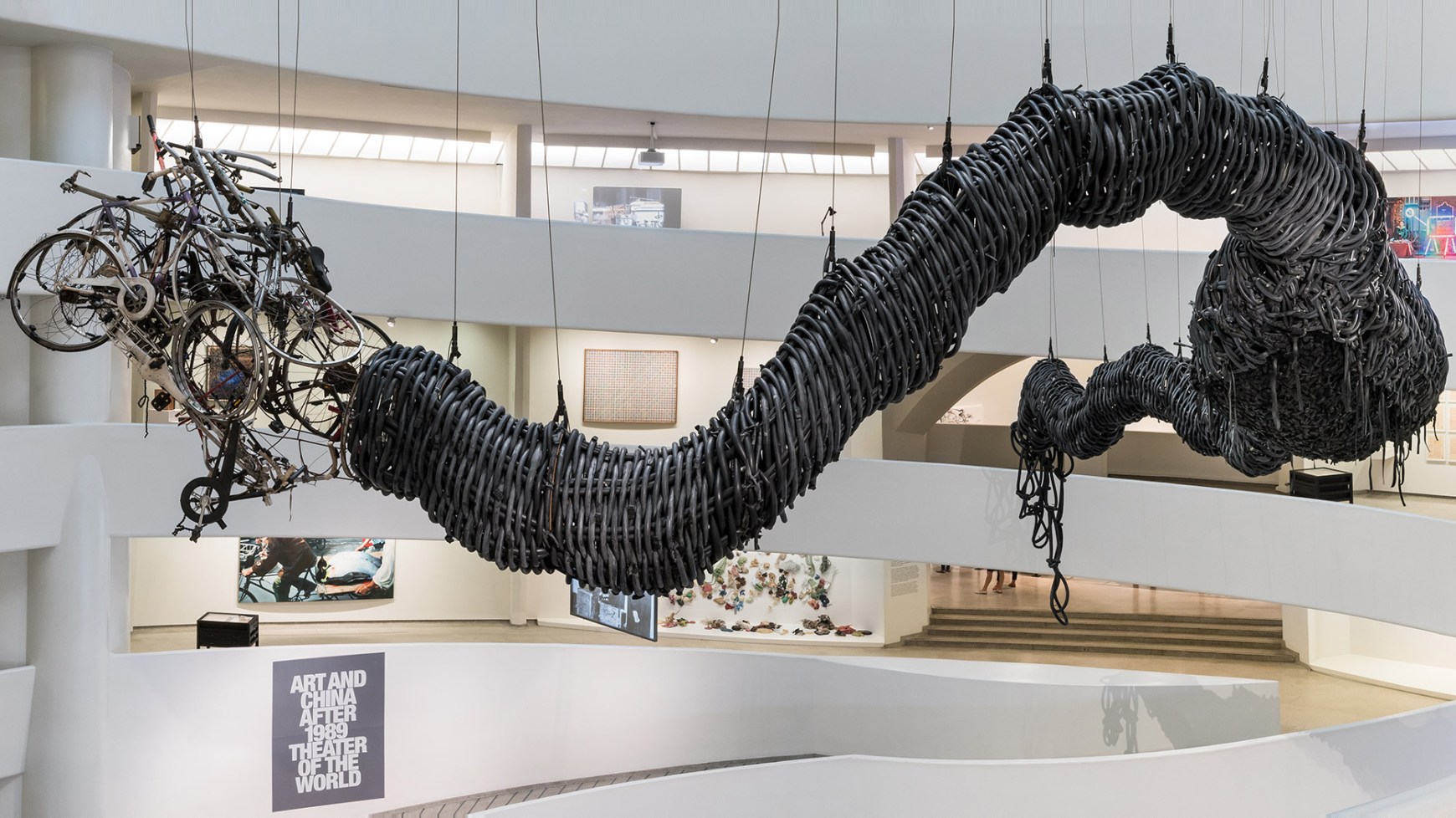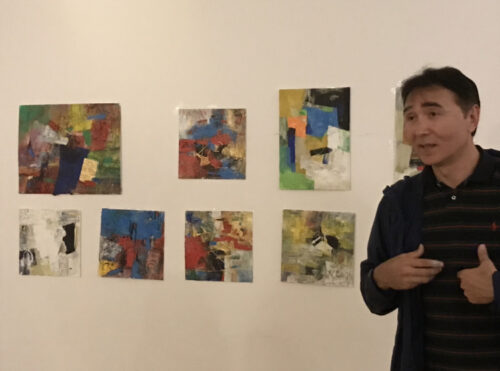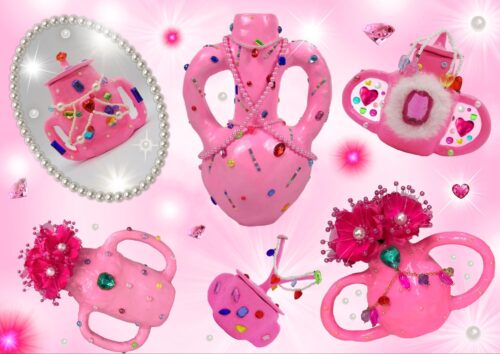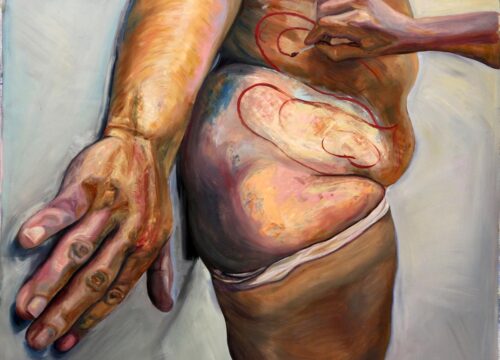10 can’t-miss artworks at the Guggenheim’s ‘Art and China after 1989: Theater of the World’
An enormous, ambitious new exhibition at the Guggenheim in New York highlights work by 71 artists and groups across China.

“Art and China after 1989: Theater of the World,” on right now at the Solomon R. Guggenheim Museum, is an art show of massive proportions. Taking up the entire rotunda and two additional galleries of the landmark Frank Gehry building, it’s easy to become overwhelmed when there’s a 65-foot dragon soaring above your head.
But between the crowds and the mythical beasts, here are 10 pieces worth a second (or seventh) glance as you make your way through two decades’ worth of Chinese contemporary art.
Huang Yong Ping, The History of Chinese Painting and A Concise History of Modern Painting Washed in a Washing Machine for Two Minutes

Who doesn’t love an artistic practical joke to break the ice? One of the founding members of Xiamen Dada, Huang Yong Ping 黄永砯, tongue firmly planted in cheek, manages to subvert traditional art history while paying homage to Marcel Duchamp and the tradition of readymades. Why not remind viewers that all art really is chewed-up wet paper and shattered glass, with a purpose.
Geng Jianyi, Forms and Certificates (detail)

Geng Jianyi 耿建翌 sent multiple artists mock registration forms asking questions about their private lives. The above are the answers of curator Fei Dawei 费大为 — founding director of the Ullens Center for Contemporary Art — who cottoned on to Geng’s motives and doubled down on absurd answers. From date of birth (1864) and photo (upside-down!) onwards, Fei fully leans into the spirit and not the letter of the questionnaire, revealing his favorite plant (algae), animal (a bullhead catfish), and person (triplets).
Zeng Fanzhi, Meat

You might be tempted to motor through the Social Realist portion of the exhibition, which coincides with the explosion of growth following Deng Xiaoping-era economic reforms. Don’t. Although the techniques and subjects may appear traditional at first glance, artists such as Zeng Fanzhi 曾梵志, Yu Hong 喻红, Zhao Bandi 赵半狄, and Liu Xiaodong 刘小东 captured the despair and hopelessness of those left behind by the scramble for private ownership and liquidation of state-owned enterprises. Ironically, these artists are some of the most financially successful: their works regularly fetch record prices at auction.
Wang Gongxin, Sky of Brooklyn — Digging a Hole in Beijing; Sky of Beijing — Digging a Hole in New York


After nearly 10 years in New York, Wang Gongxin王功新 returned to China in 1995 and promptly found a way to bring Brooklyn to Beijing (before anyone opened a cocktail bar inside a hutong). The twinned works depict videos of the sky in either Beijing or New York from the bottom of a well, accompanied by Wang’s gravelly baritone intoning, “What are you looking at? Just blue sky. There is nothing you can see.” Recent residents of the capital will wonder how many days it took for Wang to capture the pristine skies found in the current version of the piece, located on the ground floor of the museum.
Zheng Guogu 郑国谷: Visual Art, Add Oil! March Forward!

Military precision dressed up in whimsy and colloquialisms. Inextricably linked with the Tiananmen crackdowns of June 4, 1989, deep-fried toy tanks titled Add Oil! initally appear to be an innocent play on words of encouragement (加油 jiāyóu). But the breading adds another layer of armor to a military vehicle confronting unarmed students, and March Forward! suddenly sounds much more like a command than a request.
Chen Zhen: Fu Dao/Fu Dao, Upside-Down Buddha/Arrival at Good Fortune

The first thing you notice walking into Tower 5, which houses Chen Zhen’s 陈箴 other massive sculpture (the dragon in the rotunda is his), is the fragrance. The sharp, clean scent of drying bamboo permeates the space, creating a sense of relaxation and Zen. Although the shape of the sculpture mimics Buddhist sanctuaries, the calmness is shattered by chunks of industrial junk. Car parts, electric fans, a pachinko machine, and other detritus hang from the ancient bamboo frame, reminding viewers that the material world permeates even the most spiritual of environments.
Zhou Tiehai: There Came a Mr. Solomon to China

In 1993, the writer Andrew Solomon alighted on the shores of the Middle Kingdom, determined to crack the code of its mysterious, revolutionary young artists. The ensuing article in the New York Times Magazine was the first to spotlight Chinese contemporary art in a mainstream western publication. Less impressed was Zhou Tiehai 周铁海, who satirizes the disproportionate reaction to Western critics shedding light and imparting legitimacy on “emerging” art movements. Solomon is depicted as arriving on a gondola steered by Marco Polo himself, surrounded by other trappings of Western culture he’s ostensibly carrying East.
Qiu Zhijie: The Present Continuous Tense


One of the great talents to emerge out of the Chinese contemporary art milieu is Qiu Zhijie 邱志杰, a curator, scholar, artist, and educator. First exhibited in 1996, The Present Continuous Tense uses video to highlight the enormous impact of being physically present. Funerary wreaths frame time-lapse videos of flowers blooming, ancestral portraits, and a live feed of viewers framed in the space of the exhibition — physically present until the shuffle off-screen, out of the frame, off the mortal coil.
Shen Yuan: History of Nanling 1957-2005

A historical survey of a southern Chinese village, History of Nanling is one of the more poetic pieces in the show. Interviews with residents who have witnessed their village, county, and region change, their recollections painted on paper with broad brushstrokes, and Shen Yuan’s 沈远 own watercolor depictions combine to create an idealized history that is kinder to all. The snippets of conversation and overlapping sheets of paper highlight the fickleness of memory, significance of place, and trickle-down effect of partial perspective that evolves into myth and history.
Ai Weiwei: Fairytale

Fairytale highlights a crossroads in the career of Ai Weiwei 艾未未, perhaps China’s most visible artist today. Realized prior to the 2008 earthquake and scrutiny that has colored his life and work for the past 10 years, Fairytale incorporates many of the elements Ai would continue to utilize in his investigative work — strangers, the internet, constant surveillance — while remaining a beautiful, idealistic chamber piece predicated on the desire to make wishes come true.
Art and China after 1989: Theater of the World will be at the Guggenheim until January 7, 2018.
Also see:
Guggenheim’s controversial China exhibition revels at the intersection of art and politics





